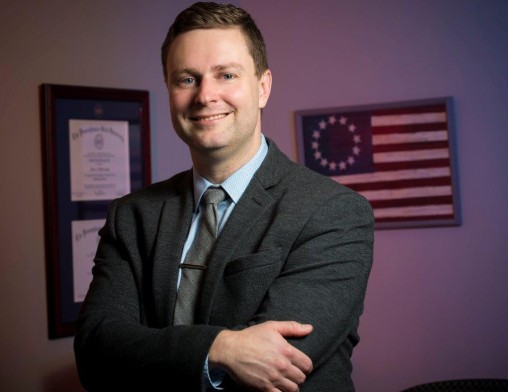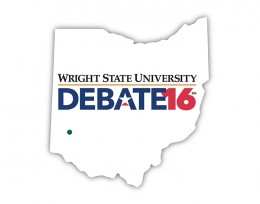
Lee Hannah, assistant professor of political science, is teaching Introduction to American Politics, gearing the course to the buildup to the debate, and in the fall, will teach a Presidential Election class. (Photo by Erin Pence)
Wright State is a perfect location to host the first presidential debate because the university is a crystal ball into the future of higher education — a critical issue for the candidates, says Lee Hannah, assistant political science professor.
With about 18,000 students drawn largely from the 18 surrounding counties, Wright State serves a highly diverse population that includes many military students and students with disabilities. Many students are first-generation and nontraditional college students. Ten percent of undergraduates are age 30 and older.
Wright State also has a fast-growing population of international students, its online programs are nationally ranked, and it has one of the lowest tuition rates of four-year public universities in Ohio.
“I think Wright State is a picture of the future of education in terms of being affordable, diverse, flexible,” said Hannah.
Wright State is hosting the first general election presidential debate on Sept. 26. The debate is expected to be in the national and international spotlight and attract thousands of media members.
Being the first of four debates, the Wright State event will likely draw the most viewers, Hannah said.
“The candidates will have been talking about each other for months, and now they’ve got to stand across from each other,” he said. “I always think that’s interesting, even from the body language aspect. My guess is that most people will tune in for the first one because they want to compare and contrast.”
 Hannah says he will be looking for that “moment” in the debate that can determine the outcome of the race.
Hannah says he will be looking for that “moment” in the debate that can determine the outcome of the race.
“Is anyone going to land a punch?” he said.
Hannah says that people watching the debate from around the region will likely be interested in terrorism and international relations. The university is located in the shadow of Wright-Patterson Air Force Based and there are many links between the two.
“You’re going to have a lot of military families in the viewing audience,” Hannah said. “Foreign policy might become bigger because of that factor, being right next to a military base.”
And those watching the debate from around the region will almost certainly be interested in the economy, Hannah said.
“I think Ohio has seen the same kind of industry issues that the rest of the country has. It’s a microcosm,” he said. “So you think about the future of manufacturing. What are the candidates going to do about stagnant wages, the unemployed?”
Hannah is currently teaching Introduction to American Politics, gearing the course to the buildup to the debate. In the fall, he will teach a Presidential Election class.
“We’ll be going from August, through the election and then trying to understand it at the end,” he said. “The course will focus on broader theories about campaigns and elections, what the research has shown about the value of political ads and debates in prior elections and whether these trends will hold in 2016.”
The course will also examine the pros and cons of polling and the role of the media.
“It will be pretty all-encompassing,” he said.

 Wright State University Foundation awards 11 Students First Fund projects
Wright State University Foundation awards 11 Students First Fund projects  Gov. DeWine reappoints Board Treasurer Beth Ferris and names student Ella Vaught to Wright State Board of Trustees
Gov. DeWine reappoints Board Treasurer Beth Ferris and names student Ella Vaught to Wright State Board of Trustees  Joe Gruenberg’s 40-Year support for Wright State celebrated with Honorary Alumnus Award
Joe Gruenberg’s 40-Year support for Wright State celebrated with Honorary Alumnus Award  Wright State’s elementary education program earns A+ rating for math teacher training
Wright State’s elementary education program earns A+ rating for math teacher training  Wright State’s Calamityville hosts its largest joint medical training operation
Wright State’s Calamityville hosts its largest joint medical training operation 